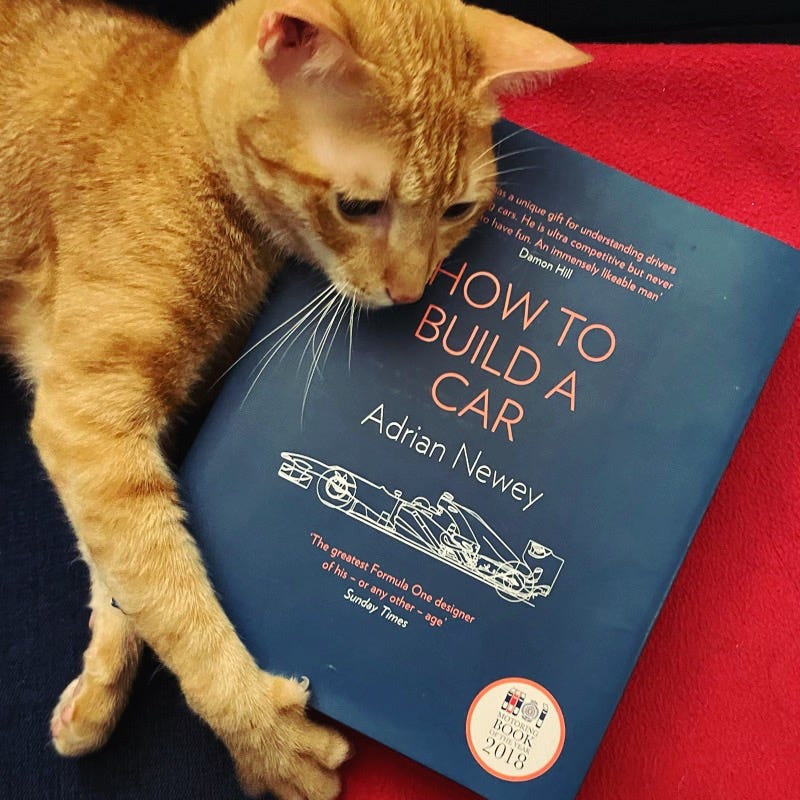Book Review: How to Build a Car by Adrian Newey
As a new fan of Formula 1, I had never heard of Adrian Newey.
Karun Chandok, one of the F1 commentators, mentioned this book on air and it seemed like an interesting way to gain a better understanding of the the sport and its cars. It turns out Newey is instrumental in designing the changing face of Formula 1 race cars over three-odd decades. This book is a history of that journey in his own words.
Its tone is light-hearted, relaxed and entertaining. This is not a complicated or intimidating read for one who knows nothing about cars. The book’s inside jacket sums it perfectly: it “encapsulates, through Adriano’s remarkable life story, precisely what makes F1 so thrilling- it’s potential for the total synchronicity of man and machine, the perfect combination of style, efficiency and speed.” It didn’t dawn on me until I read it that this hunt for the greatest efficiency is what draws me to the sport. The competition is calculated in one thousands of a second - it doesn’t get more nail-biting than this. And yet, efficiency cannot overcome human error and inevitable entropy and that is what makes the sport so unpredictable and exciting.
The book is divided by sections entitled “How to build a (name of car)”, acting as a backbone for chapters in his storied career from humble beginnings to his first job all the way till the present. Over a lifetime, there are transitions from one mega car company to another, corporate politics, regulation battles, personal challenges and family upheavals but through it all, his central motivation remains unwavering - to design and build a car that is better and goes faster than its predecessor. This drive to best himself and strive for improvement is what makes this a racy read that stays on track (all puns intended). The mechanical descriptions feature alongside Newey’s beautiful technical drawings and are easy enough to follow thanks to his explainers.
His writing (or his ghost writer) is able to distill life to its particularly human, relatable and funny tails that sometimes hold a lesson, if you look close enough. The mistakes he relates are so prosaic that it’s almost funny to imagine them being made by someone considered a genius. In one instance, he drops a pen cap into the oil tank of the car, doesn’t have time to retrieve it and gets on with the race, hoping that the filter at the bottom will catch - which it thankfully does. The silliest things can happen with even the best minds on the job, harking back to the idea that while the sport strives for perfection, man will always face obstacles simply because he is human.
His most infamous design is the car in which Ayrton Senna, a legend of the sport, died on the track in 1994. In revisiting this, Newey walks the wire and is able to strike a balance by breaking down the process of constructing car itself and the struggles the team had with it over the season and the personal experience of the trauma and its aftermath including court cases that dragged on. It humanises a mythically tragic story. He’s no stranger to crashes himself, having been in a handful - from driving rashly on company time to having drivers fall asleep at the wheel during transit between races to the aftermath of one nearly life-ending crash described in a short sentence about a doctor sticking his thumb in his mouth to manipulate his skull back into shape.
The latest and longest chapter in his career has been with Red Bull (which we’ll try not to hold against him). Having joined the company from basically the beginning, he is largely responsible for them winning back-to-back championships and he outlines that journey with deceptive simplicity and humility.
If you’ve come to F1 thanks to Drive to Survive as I have, this book has just the right amount of history, personal yarns and theories behind development of car designs to get you up to speed. Newey’s tussle with the ever-changing regulations (usually in an effort to make the cars safer) encapsulates the FIA’s clash with team engineers who must find a way for the car to go faster even if it means finding and exploiting all possible loopholes. This especially throws light on the latest season which embarks on a new phase in the sport. All this, told by one who has a wider lens on the big picture, makes for an illuminating read. I’d recommend this book to anyone who enjoys any of these subjects - F1, race cars and well-written biographies.



